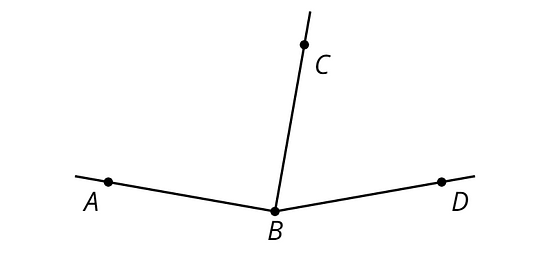Lesson 1Relationships of Angles
Let’s examine some special angles.
Learning Targets:
- I can find unknown angle measures by reasoning about adjacent angles with known measures.
- I can recognize when an angle measures , , or .
1.1 Visualizing Angles
Use the applet to answer the questions.
- Which angle is bigger, or ?
- Identify an obtuse angle in the diagram.
1.2 Pattern Block Angles
- Look at the different pattern blocks inside the applet. Each block contains either 1 or 2 angles with different degree measures. Which blocks have only 1 unique angle? Which have 2?
-
If you place three copies of the hexagon together so that one vertex from each hexagon touches the same point, as shown, they fit together without any gaps or overlaps. Use this to figure out the degree measure of the angle inside the hexagon pattern block.

- Figure out the degree measure of all of the other angles inside the pattern blocks. (Hint: turn on the grid to help align the pieces.)
Are you ready for more?
We saw that it is possible to fit three copies of a regular hexagon snugly around a point.
Each interior angle of a regular pentagon measures . Is it possible to fit copies of a regular pentagon snugly around a point? If yes, how many copies does it take? If not, why not?

1.3 More Pattern Block Angles
-
Use pattern blocks to determine the measure of each of these angles.

- If an angle has a measure of then the two legs form a straight line. An angle that forms a straight line is called a straight angle. Find as many different combinations of pattern blocks as you can that make a straight angle.
Use the applet if you choose. (Hint: turn on the grid to help align the pieces.)
1.4 Measuring Like This or That
Tyler and Priya were both measuring angle .

Lesson 1 Summary
When two lines intersect and form four equal angles, we call each one a right angle. A right angle measures . You can think of a right angle as a quarter turn in one direction or the other.

An angle in which the two sides form a straight line is called a straight angle. A straight angle measures . A straight angle can be made by putting right angles together. You can think of a straight angle as a half turn, so that you are facing in the opposite direction after you are done.

If you put two straight angles together, you get an angle that is . You can think of this angle as turning all the way around so that you are facing the same direction as when you started the turn.

When two angles share a side and a vertex, and they don't overlap, we call them adjacent angles.
Glossary Terms
Adjacent angles share a side and a vertex.
In this diagram, angle is adjacent to angle .

A right angle is half of a straight angle. It measures 90 degrees.
A straight angle is an angle that forms a straight line. It measures 180 degrees.
Lesson 1 Practice Problems
Here are questions about two types of angles.
Draw a right angle. How do you know it’s a right angle? What is its measure in degrees?
Draw a straight angle. How do you know it’s a straight angle? What is its measure in degrees?
An equilateral triangle’s angles each have a measure of 60 degrees.
-
Can you put copies of an equilateral triangle together to form a straight angle? Explain or show your reasoning.
-
Can you put copies of an equilateral triangle together to form a right angle? Explain or show your reasoning.
-
Here is a square and some regular octagons.
In this pattern, all of the angles inside the octagons have the same measure. The shape in the center is a square. Find the measure of one of the angles inside one of the octagons.

The height of the water in a tank decreases by 3.5 cm each day. When the tank is full, the water is 10 m deep. The water tank needs to be refilled when the water height drops below 4 m.
- Write a question that could be answered by solving the equation .
- Is 100 a solution of ? Write a question that solving this problem could answer.
Use the distributive property to write an expression that is equivalent to each given expression.
Lin’s puppy is gaining weight at a rate of 0.125 pounds per day. Describe the weight gain in days per pound.